View in other NatureServe Network Field Guides
NatureServe
Montana
Utah
Wyoming
Idaho
Wisconsin
British Columbia
South Carolina
Yukon
California
New York
Low Braya - Braya humilis
Other Names:
Neotorularia humilis
State Rank Reason (see State Rank above)
Known from four locations in the state, including one site in which only one plant was observed. One population occurs in an area with historical mining activity and may have been detrimentally impacted. Another populations occurs along the Rocky Mtn Front and is actively monitored; population levels may be declining at this site based upon preliminary data.
General Description
Plants: Braya is a short-lived perennial with 1 to several erect to prostrate stems, 3-20 cm long, which arise from a simple or branched rootcrown and taproot.
Leaves: The numerous basal leaves are lance-shaped and 1-3 cm long with entire or toothed margins. The widely spaced stem leaves are alternate and smaller. Foliage is sparsely to densely covered with simple and branched hairs.
Flowers: Borne on short stalks in terminal clusters that expand as the fruit matures. Each flower has 4 white petals, which are 3-4 mm long, 4 sepals, 4 long stamens, and 2 short stamens.
Fruit: The erect or spreading linear fruits (siliques) are puberulent (Lesica 2012), ca 1-3 cm in length, 0.6-2 mm in width, and typically straight, but occasionally torulose (constricting between the seeds) (FNA 2010).
Phenology
Flowering from mid-June at lower elevation sites to late July in alpine settings.
Species Range
Montana Range
Range Descriptions

 Native
Native
Range Comments
Alaska to Greenland south to British Columbia, Alberta, and Vermont with disjunct populations in western Montana, northwest Wyoming and central Colorado.
Observations in Montana Natural Heritage Program Database
Number of Observations: 74
(Click on the following maps and charts to see full sized version)
Map Help and Descriptions
Relative Density
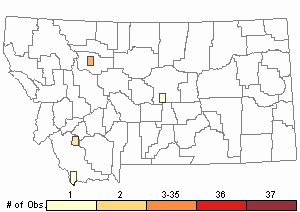
Recency
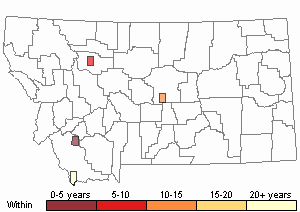
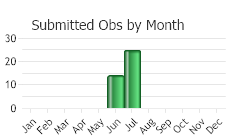
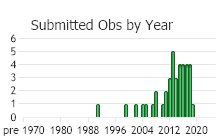
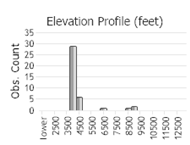 (Observations spanning multiple months or years are excluded from time charts)
(Observations spanning multiple months or years are excluded from time charts)
Habitat
Sparsely vegetated, vernally moist, calcareous soil in the alpine zone and similar sites with sparse vegetation cover dominated by Potentilla fruticosa, Carex scirpoidea, Phlox kelsey and Zigadenus elegans in montane settings along the Rocky Mtn Front.
National Vegetation Classification System Groups Associated with this Species
Alpine
Alpine - Sparse and Barren
Alpine - Vegetated
Wetland and Riparian
Alpine Riparian and Wetland
Peatland
Stewardship Responsibility
Threats or Limiting Factors
STATE THREAT SCORE REASON
Reported threats to Montana's populations of Low Braya are currently assigned as unknown. Among few, small, and geographically isolated populations, one occurs in an area of extensive historic mining activity. This area may have potential for mining operations to return, but this is unlikely to be relevant in a 10-year time frame (MTNHP Threat Assessment 2021).
References
- Literature Cited AboveLegend:
 View Online Publication
View Online Publication Colorado Natural Heritage Program. 1997. Colorado Rare Plant Field Guide. Fort Collins, CO: Colorado State University.
Colorado Natural Heritage Program. 1997. Colorado Rare Plant Field Guide. Fort Collins, CO: Colorado State University. Flora of North America Editorial Committee, eds. 2010. Flora of North America North of Mexico. Volume 7. Magnoliophyta: Salicaceae to Brassicaceae. Oxford University Press, Inc., NY. 832 pp.
Flora of North America Editorial Committee, eds. 2010. Flora of North America North of Mexico. Volume 7. Magnoliophyta: Salicaceae to Brassicaceae. Oxford University Press, Inc., NY. 832 pp. Lesica, P., M.T. Lavin, and P.F. Stickney. 2012. Manual of Montana Vascular Plants. Fort Worth, TX: BRIT Press. viii + 771 p.
Lesica, P., M.T. Lavin, and P.F. Stickney. 2012. Manual of Montana Vascular Plants. Fort Worth, TX: BRIT Press. viii + 771 p. MTNHP Threat Assessment. 2021. State Threat Score Assignment and Assessment of Reported Threats from 2006 to 2021 for State-listed Vascular Plants. Botany Program, Montana Natural Heritage Program, Helena, Montana.
MTNHP Threat Assessment. 2021. State Threat Score Assignment and Assessment of Reported Threats from 2006 to 2021 for State-listed Vascular Plants. Botany Program, Montana Natural Heritage Program, Helena, Montana.
- Additional ReferencesLegend:
 View Online Publication
View Online Publication
Do you know of a citation we're missing? Carron, J. No date. Population and extinction probability modeling of Braya humilis. The Nature Conservancy, Colorado Field Office. 9 pp.
Carron, J. No date. Population and extinction probability modeling of Braya humilis. The Nature Conservancy, Colorado Field Office. 9 pp. Lesica, P. and P. F. Stickney. 1994. Noteworthy collections: Montana. Madrono 41:228-231.
Lesica, P. and P. F. Stickney. 1994. Noteworthy collections: Montana. Madrono 41:228-231. Lesica, P., M.T. Lavin, and P.F. Stickney. 2022. Manual of Montana Vascular Plants, Second Edition. Fort Worth, TX: BRIT Press. viii + 779 p.
Lesica, P., M.T. Lavin, and P.F. Stickney. 2022. Manual of Montana Vascular Plants, Second Edition. Fort Worth, TX: BRIT Press. viii + 779 p.
- Web Search Engines for Articles on "Low Braya"





